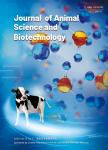Dominant changes in the breast muscle lipid profiles of broiler chickens with wooden breast syndrome revealed by lipidomics analyses
Dominant changes in the breast muscle lipid profiles of broiler chickens with wooden breast syndrome revealed by lipidomics analyses作者机构:Institute of Animal SciencesChinese Academy of Agricultural SciencesState Key Laboratory of Animal NutritionKey Laboratory of Animal(Poultry)Genetics Breeding and ReproductionMinistry of AgricultureBeijingChina
出 版 物:《Journal of Animal Science and Biotechnology》 (畜牧与生物技术杂志(英文版))
年 卷 期:2022年第13卷第6期
页 面:1703-1713页
核心收录:
基 金:supported by grants from the National Natural Science Foundation of China(31772591) the Agricultural Science and Technology Innovation Program(CAAS-ZDRW202005) the China Agriculture Research System of MOF and MARA(CARS-41).
主 题:Broiler chicken Lipid profle Liver Serum Wooden breast
摘 要:Background: Chicken is the most consumed meat worldwide and the industry has been facing challenging myopathies. Wooden breast(WB), which is often accompanied by white striping(WS), is a serious myopathy adversely affecting meat quality of breast muscles. The underlying lipid metabolic mechanism of WB affected broilers is not fully understood.Results: A total of 150 chickens of a white-feathered, fast-growing pure line were raised and used for the selection of WB, WB + WS and control chickens. The lipids of the breast muscle, liver, and serum from different chickens were extracted and measured using ultra performance liquid chromatography(UPLC) plus Q-Exactive Orbitrap tandem mass spectrometry. In the breast, 560 lipid molecules were identified. Compared to controls, 225/225 of 560 lipid molecules(40.2%) were identified with differential abundance(DA), including 92/100 significantly increased neutral lipids and 107/98 decreased phospholipids in the WB/WB + WS groups, respectively. The content of monounsaturated fatty acids(MUFA) was significantly higher, and the polyunsaturated fatty acids(PUFA) and saturated fatty acids(SFA) were significantly lower in the affected breasts. In the liver, 434 lipid molecules were identified, and 39/61 DA lipid molecules(6.7%/14.1%) were detected in the WB and WB + WS groups, respectively. In the serum, a total of 529 lipid molecules were identified and 4/44 DA lipid molecules(0.8%/8.3%) were detected in WB and WB + WS group, respectively. Compared to controls, the content of MUFAs in the serum and breast of the WB + WS group were both significantly increased, and the content of SFAs in two tissues were both significantly decreased. Only five lipid molecules were consistently increased in both liver and serum in WB + WS group.Conclusions: We have found for the first time that the dominant lipid profile alterations occurred in the affected breast muscle. The relative abundance of 40.2% of lipid molecules were changed and is characteristic of increased neutral lipids and decreased phospholipids in the affected breasts. Minor changes of lipid profiles in the liver and serum of the affected groups were founded. Comprehensive analysis of body lipid metabolism indicated that the abnormal lipid profile of WB breast may be independent of the liver metabolism.



